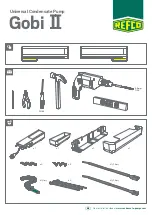
-
83
-
(2)
Refrigerant charging
(a)
After the evacuation shown in the above, change the connection of the charge hose
A
to the refrigerant cylinder.
(b)
Purge air from the charge hose
A
.
First loosen the connecting portion of the charge hose at the gauge manifold side and open valve
3
for a few seconds, and
then immediately retighten it after observing that gas has blown out from loosened connecting portion.
(c)
Open valves
1
and
3
then gas refrigerant begins flowing from the cylinder into the unit.
When refrigerant has been charged into the unit to some extent, refrigerant flow becomes stagnant. When that happens, start
the compressor in cooling cycle until the system is filled with the specified amount of gas, then close valves
1
and
3
and
remove the gauge manifold. Cover the service port with caps and tighten them securely.
(d)
Check for gas leakage by applying a gas leak detector around the piping connection.
(e)
Start the air conditioner and make sure of its operating condition.
1.6.2
Trouble shooting for refrigerant circuit
(1)
Judgement of operating condition by operation pressure and temperature difference
Making an accurate judgement requires a skill that is acquired only after years of experience, one trouble may lead to an another
trouble from a single trouble source and several other troubles may exist at the same time which comes from a undetected different
trouble source.
Filtering out the trouble sources can be done easier by comparing with daily operating conditions. Some good guides are to judge
the operating pressure and the temperature difference between suction air and delivery air.
Following are some pointers,
Pressure
Trouble cause
High side
●
Low side
●
High side
●
Ineffective compression
Low side
●
(defective compressor)
High side
●
Low side
●
High side
●
Low side
●
High side
●
Low side
●
1) Too high temperature of room
1) Insufficient refrigerant in circuit
2) Clogging of strainer
3) Gas leakage
4) Clogging of air filter (in cooling)
5) Decrease in heat load (in cooling)
6) Locking of indoor fan (in cooling)
1) Locking of outdoor unit fan (in cooling)
2) Dirty outdoor heat exchanger (in cooling)
3) Mixture of non condensable gas (air etc.)
1) Excessive overcharging of refrigerant
2) Mixture of non condensable gas (air etc.)
Indi-
cation
Circuit
T
oo lo
w
A little lo
w
Normal
A little
high
T
oo high
















































